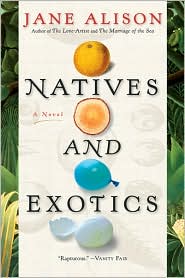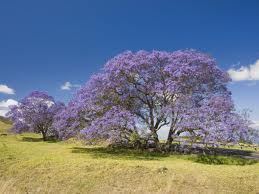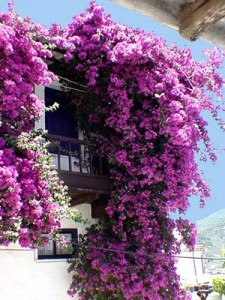“It was 1822. All over the globe civilization was advancing; things were being transformed, unearthed, transplanted….Wattle and eucalypts from Australia, jacaranda from the Argentine, and bougainvillea from Brazil. The living world was rearranged.”
“Nativ es” and “exotics,” terms often used to describe the relationship of plants to their environments, also refers, in this novel, to the characters who populate it, since all of the main characters live in foreign environments which have their own native populations. The Forder family, in the first of three major story lines, is on assignment in Ecuador in 1970, where the father works for the US State Department. Rosalind Forder, the mother, and Alice, her daughter, are doubly displaced since they are originally from Australia.
es” and “exotics,” terms often used to describe the relationship of plants to their environments, also refers, in this novel, to the characters who populate it, since all of the main characters live in foreign environments which have their own native populations. The Forder family, in the first of three major story lines, is on assignment in Ecuador in 1970, where the father works for the US State Department. Rosalind Forder, the mother, and Alice, her daughter, are doubly displaced since they are originally from Australia.
In the second section, which takes place in 1929, Violet Clarence (Rosalind’s mother) is living in the bush in Australia, having joyfully given up a career as a teacher in order to marry Alf and help clear the land to build a home in the bush. Because her family came from England in the distant past, she has always regarded England as “home.” Part III follows a distant relative, a Mr. Clarence, who in 1822 lives in Scotland, though he is not Scottish. He and his foster son George emigrate to St. Michael in the Portuguese Azores after their land is seized by the British factor.

In each of these three story lines, the “exotic,” foreign residents permanently affect the environments in which they live—Mr. Forder by manipulating the fluid Ecuadorian political system so that American tuna companies can reap record harvests in Ecuadorian waters and so that an oil pipeline can be constructed through “useless” jungle; Violet and her husband through their work clearing land for farming and sheepherding; and Mr. Clarence and George through their importation to the Azores of exotic plants and new kinds of orange trees from other parts of the world.
Alison clearly believes that despoiling a natural environment by removing or adding new plants and/or animals is both dangerous and foolish, no matter how honorable the motives might be, and she is even clearer on the subject of colonialism, both the old colonialism of the British Empire and what she considers the more recent colonialism of the US. Hal Forder’s notion that “[Development in Ecuador] is not a matter of right…it’s a matter of responsibility,” is shown to have permanent, ineradicable effects, both on the natural environment and on the local people who inhabit it.
 Alison is first and foremost a novelist telling a good story, however, and she does not become polemical, softening her message through the love that some of the characters feel for the environment and through sensuous, lyrical passages of immense beauty. Young Alice loves the natural world in Ecuador—”She felt opened up and seared…all at once she was ripped open; all that light and color poured into her. It could not be encompassed by words such as love or like; it was moving and growing and green and live, even the ground smoking, steaming.”
Alison is first and foremost a novelist telling a good story, however, and she does not become polemical, softening her message through the love that some of the characters feel for the environment and through sensuous, lyrical passages of immense beauty. Young Alice loves the natural world in Ecuador—”She felt opened up and seared…all at once she was ripped open; all that light and color poured into her. It could not be encompassed by words such as love or like; it was moving and growing and green and live, even the ground smoking, steaming.”
 Her descriptions of geological processes and eras are so vivid the reader is transported to a different world, making the contrasts effected by civilization more strongly felt—”Far away, in the jungle or near the coastal plains, tropical trees were being cut down to make room for the [Pan-American] highway and pipeline, and soil that was loosened by the removal of roots began to slide, great mud slides that covered villages completely so that you wouldn’t know anything had ever been there. Just as living things had once been covered by silt and over millions of years transformed, but now rose again, bubbled up warm and sometimes flaming, pure vaporous energy, inanimate life.”
Her descriptions of geological processes and eras are so vivid the reader is transported to a different world, making the contrasts effected by civilization more strongly felt—”Far away, in the jungle or near the coastal plains, tropical trees were being cut down to make room for the [Pan-American] highway and pipeline, and soil that was loosened by the removal of roots began to slide, great mud slides that covered villages completely so that you wouldn’t know anything had ever been there. Just as living things had once been covered by silt and over millions of years transformed, but now rose again, bubbled up warm and sometimes flaming, pure vaporous energy, inanimate life.”
 A powerfully descriptive book with a theme of particular relevance today, Natives and Exotics is a memorable novel with believable characters who often try and equally often fail to do what is right. Her displaced characters and their difficulties in adapting to their lives humanize her themes, broaden her scope, and put man into a geological perspective—as a relatively new but dangerous species which, nevertheless, has the capacity to learn from experience.
A powerfully descriptive book with a theme of particular relevance today, Natives and Exotics is a memorable novel with believable characters who often try and equally often fail to do what is right. Her displaced characters and their difficulties in adapting to their lives humanize her themes, broaden her scope, and put man into a geological perspective—as a relatively new but dangerous species which, nevertheless, has the capacity to learn from experience.
Notes: The author’s photo is part of her Amazon Author page.
The jacaranda tree, native of Argentina, has been imported successfully intoHawaii, in which it is an “exotic”: http://www.panoramio.com (Photo by Eric Rolph)
Bougainvilleas, native to Brazil, are seen in the next photo growing “exotically” in Greece: http://www.skopelos.net
Eucalyptus, native to Australia, can be seen growing as an “exotic” at Hiroshima Castle in Japan. This particular tree is said to be over a hundred years old, having withstood the atomic bombing and numerous typhoons. http://www.lang-arts.com
